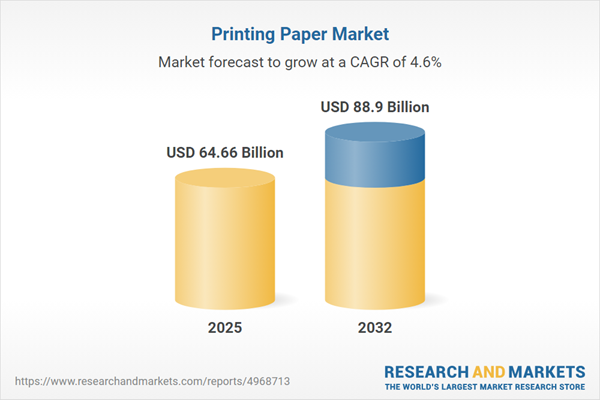Speak directly to the analyst to clarify any post sales queries you may have.
Senior decision-makers in the printing paper market are adapting to complex shifts in sustainability, regulation, and digital transformation. Effective leadership depends on actionable intelligence that unlocks operational agility and supply chain resilience, positioning organizations to seize new growth opportunities.
Market Snapshot: Printing Paper Market Trends and Outlook
The global printing paper market is projected to progress from USD 61.81 billion in 2024 to USD 64.66 billion in 2025 and is expected to achieve USD 88.90 billion by 2032, reflecting a compound annual growth rate (CAGR) of 4.64%. This trajectory highlights robust sector momentum, powered by sustainability mandates, regulatory complexity, and advancing technologies streamlining manufacturing and supply chain operations. Executive teams are proactively shaping supplier strategies and adaptive management models to meet new compliance standards and foster innovation, ensuring risk is managed and procurement strategies remain strong in this evolving market.
Scope & Segmentation: Key Drivers within the Printing Paper Market
- Product Category: Gloss, matte, and silk types deliver high-impact communications, while groundwood, thermomechanical, and recycled variants align with sustainability goals. Bleached and unbleached wood-free papers meet specialized communication and operational needs across multiple industries.
- Basis Weight: Heavyweight grades support packaging integrity and transit protection. Mediumweight sheets balance cost with durability, and lightweight stocks meet the needs of bulk mailings or high-volume distribution with efficiency.
- Application: Printing papers enable both digital and offset print processes suited to uses such as catalogs, business communications, educational resources, and dynamic publishing needs.
- End Use Industry: Advertising relies on specialty grades for impactful campaigns. Academic and publishing sectors require consistent formats to support curriculum, periodicals, and resource distribution.
- Region: The Americas benefit from robust compliance processes and consistent production environments. EMEA demonstrates regulatory diversity, requiring nuanced market navigation, while Asia-Pacific is driven by digitalization and a strong manufacturing infrastructure, expanding application innovation in e-commerce and packaging channels.
- Leading Companies: International Paper Company, Oji Holdings Corporation, Stora Enso Oyj, Asia Pulp & Paper Co. Ltd., WestRock Company, UPM-Kymmene Corporation, Mondi plc, Smurfit Kappa Group plc, Nine Dragons Paper (Holdings) Limited, and Sappi Limited set market direction through investments in technology and product development.
Key Takeaways: Strategic Insights for Senior Printing Paper Leaders
- Manufacturers are optimizing supply and production systems to heighten agility and address the intensifying focus on environmental and regulatory expectations across global regions.
- Continuous improvements in coatings and substrates help suppliers align with emerging digital workflows and evolving customer preferences for both traditional and modern applications.
- Procurement teams are broadening supplier networks and leveraging adaptive sourcing strategies, enhancing risk management as market conditions change.
- Regular assessment of global and localized regulatory changes allows organizations to remain flexible and well-positioned to enter or expand in new markets.
- Operational consistency is reinforced in the Americas and EMEA by logistics efficiency, while technological advances and digitization fuel sustained growth in Asia-Pacific markets.
Tariff Impact: Navigating US Trade Policy and Supply Chain Adjustments
Anticipated US tariffs in 2025 will increase the necessity for well-structured supplier contracts and calculated pricing approaches. Leaders are responding with scenario-based planning and deeper supplier engagement to maintain agility as global trade policies shift.
Methodology & Data Sources
This report synthesizes insights from authoritative trade publications, official industry and regulatory documentation, and consultation with senior professionals. All data undergoes rigorous expert review and scenario-based validation, establishing credibility and reliability for informed executive decisions.
Why This Report Matters
- Clarifies how new regulations, digitization, and sustainability objectives shape procurement priorities and supply chain resilience for market leaders.
- Provides clear benchmarks and enhances risk awareness, empowering executives to proactively manage operational shifts in a complex sector.
- Supports the identification of process efficiencies and swift adaptation to evolving industry requirements and regulatory frameworks.
Conclusion
This analysis offers senior executives a targeted perspective to reinforce supplier relationships, streamline risk management, and drive enduring growth in the global printing paper sector.
Additional Product Information:
- Purchase of this report includes 1 year online access with quarterly updates.
- This report can be updated on request. Please contact our Customer Experience team using the Ask a Question widget on our website.
Table of Contents
3. Executive Summary
4. Market Overview
7. Cumulative Impact of Artificial Intelligence 2025
Companies Mentioned
The companies profiled in this Printing Paper market report include:- International Paper Company
- WestRock Company
- Oji Holdings Corporation
- Stora Enso Oyj
- Asia Pulp & Paper Co., Ltd.
- UPM-Kymmene Corporation
- Mondi plc
- Smurfit Kappa Group plc
- Nine Dragons Paper (Holdings) Limited
- Sappi Limited
Table Information
| Report Attribute | Details |
|---|---|
| No. of Pages | 186 |
| Published | October 2025 |
| Forecast Period | 2025 - 2032 |
| Estimated Market Value ( USD | $ 64.66 Billion |
| Forecasted Market Value ( USD | $ 88.9 Billion |
| Compound Annual Growth Rate | 4.6% |
| Regions Covered | Global |
| No. of Companies Mentioned | 11 |









